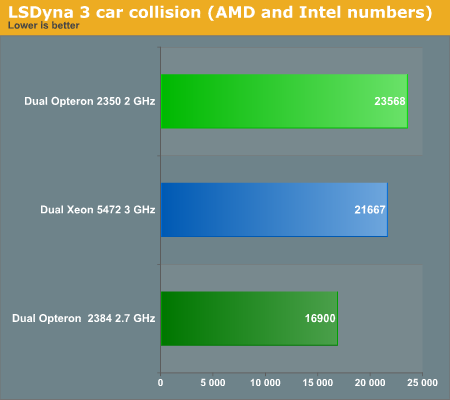The Best Server CPUs Compared, Part 1
by Johan De Gelas on December 22, 2008 10:00 PM EST- Posted in
- IT Computing
HPC
Several of the HPC benchmarks are way too expensive for us to test, and contrary to virtualization, web servers, and databases, we have little expertise in our lab to perform and fully understand these benchmarks. Nevertheless, we can get an impression from AMD's and Intel's own benchmarking. Two applications, LSDyna (Crash simulation) and Fluent (fluid dynamics) from Ansys seem to dominate the benchmark scene.

Back in 2007, the AMD 8350 was running at a paltry 2GHz, but it was already capable of keeping up with the best Intel CPUs. Intel seems to have improved its LSDyna scores a little bit. The introduction of the Xeon 5450 means that we get the same performance at a much lower TDP, but the Intel 3GHz CPU is no match for AMD's latest at 2.7GHz, as it still needs 30% more time to perform the complex crash simulation.
At the website of the Fluent benchmark we find a wealth of benchmarking info. The "Shanghai" numbers are not published there yet, so the numbers below are a combination of already published numbers (Intel) and AMD's own benchmarking numbers.

AMD's best quad-core is in a neck and neck race in the first benchmark, but the other benches show a significant (24%) to supreme (66%) advantage for the latest AMD chip. The newest AMD quad-core clearly strengthens the position of AMD in the HPC market.










29 Comments
View All Comments
Bruce Herndon - Tuesday, December 23, 2008 - link
I'm surprised by your comments. You claim that VMmark is a CPU/memory-centric benchmark. If I look at the raw data in the VMmark disclosure for Dell's R905 score of 20.35 @ 14 tiles, I see that the benchmark is driving 250-300 MB/s of disk IO across several HBAs and storage LUNs. This characteristic scales with the various systems mentioned in the article.As a designer of VMmark, I happen to know that both storage bandwidth (for the fileserver) and latency (for mail and database)are critical to acheiving good VMmark scores. Furthermore, the webserver drives substantial network IO. The only purely CPU-centric component to VMmark is the javaserver. Overall, the benchmark does exercise the entire virtualization solution - hypervisor, CPU, memory, disk, and network.
cdillon - Tuesday, December 23, 2008 - link
While SAS and Infiniband share some connectors and obtain similar data rates, they are incompatible technologies with two different purposes. Infiniband can be used for disk shelf connections, but it is less common and definitely not the case here. You should not call the connection between the Adaptec 5805 controller and the disk shelf an "Infiniband connection", even if it is using Infiniband connectors and cables, it is simply an SAS connection.JohanAnandtech - Tuesday, December 23, 2008 - link
Well, the physical layer is Infiniband, the used protocol is SCSI. I can understand calling it an "infiniband connection" maybe confusing, but the cable is an infiniband cable.shank15217 - Friday, December 26, 2008 - link
Anand, I think the above poster is right. The Adaptec RAID 5805 uses SFF-8087 connectors but the protocol is SSP (Serial SCSI Protocol). Infiniband is a physical layer protocol that shares the same connector as SAS but they are not the same. Nothing in the Adaptec RAID 5805 spec mentions Infiniband as a supported protocol.http://www.adaptec.com/en-US/products/Controllers/...">http://www.adaptec.com/en-US/products/C...ers/Hard...
niva - Tuesday, December 23, 2008 - link
I'm not sure you can run your same ol benchmark for rendering, and I'd really like more insight into what you guys are rendering and if it's indeed using all 16/24(six core 4 point system)/32(hyperthreading) cores on the system.What renderer, what scene, details details...
These chips get gobbled up by render farms and this is indeed where they can really flex their muscles to the fullest.
JohanAnandtech - Tuesday, December 23, 2008 - link
Just click on the link under "we have performed so many times before" :-)akinneyww - Tuesday, December 23, 2008 - link
I read DailyTech and anandtech.com to keep up with the latest in IT. I appreciate the thought that has gone into putting together this article. I would like to see more articles like this one.Jammrock - Tuesday, December 23, 2008 - link
The VMware results shocked me the most. I know AMD has been working hard on the virtualization sector and it looks like their work has paid off.classy - Tuesday, December 23, 2008 - link
With the rapid increase of virtualization, AMD is looking really strong. We have begun using 3.5 Vmware and are expanding the use of it. Virtualization is truly becoming a big thing in server choice.